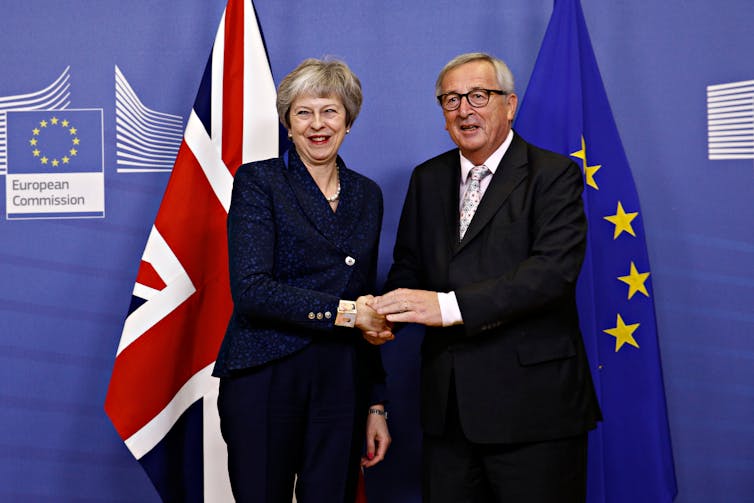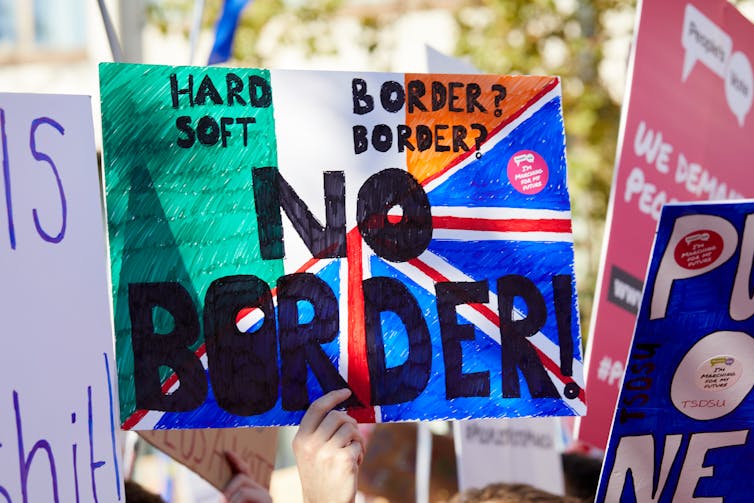The British prime minister’s request for another Brexit delay results from the intensity of diverging positions in the British parliament over Brexit. After a series of indicative votes, where no Brexit plan received majority support, we can sum up the five options as: Theresa May’s withdrawal agreement, a no-deal Brexit, staying in the customs union, staying in the single market, and the so-called Common Market 2.0 idea.
Here’s a break down of what those options mean.
1. Theresa May’s withdrawal agreement
Strike your own trade deals? Yes.
Freedom of movement? No.
EU budget contributions? Yes.
Does it solve the Irish border issue? Yes.
May’s withdrawal agreement is unpopular in the UK but has been approved by the EU. As it stands, things would remain the same for the time being, until a trade deal is organized. It avoids the need for an Irish border until then, as the UK and EU would form a customs union. In the meantime, the UK and EU would negotiate their future relationship. The broad shape of this is set out in a non-binding political declaration, which suggests the future relationship will be a comprehensive trade agreement.
In this scenario, the UK would not be bound by EU freedom of movement requirements – a fundamental principle of the EU single market that allows goods, money, services and people to move freely within the bloc. The UK would also be able to sign free trade agreements with others, as Brexiteer MPs demand. The UK would make contributions to the EU budget to participate in selected programmes of interest.

Alexandros Michailidis / Shutterstock.com
However, the withdrawal agreement specifies that if no satisfactory technological and regulatory solution is agreed for the Irish border to avoid a return of a hard border in Northern Ireland and respect the Good Friday Agreement, the UK would retain regulatory alignment with the EU. The infamous Irish backstop is an insurance mechanism and would cease to exist as soon as adequate alternative mechanisms are viable to operate customs checks without a physical border.
The prime minister’s deal places the UK on a path to a future trade agreement with the EU, the extent of which is, at present, uncertain. But whatever form it takes it will represent less access to the EU’s single market, especially for services, than at present, and some form of increased transaction costs for businesses. Remaining in a customs union or in the single market would avoid some of these, while allowing the UK to exit the formal political institutions of the EU. Yet, both options have pitfalls.
2. Customs union
Strike your own trade deals? No.
Freedom of movement? No.
EU budget contributions? Yes, but limited.
Does it solve the Irish border issue? Yes.
Remaining in a customs union would resolve the Irish border matter, and would meet May’s red line regarding ending the free movement of people. But it would commit the UK to applying the same external tariffs and restrictions on goods as the EU, and to adopt the same rules of origin for goods, as well as regulations in areas related to the customs union.
This would curtail the UK’s ability to negotiate independent, preferential trade agreements as it would have no leeway to alter EU tariffs. The flip side is that the UK would have preferential access to any country that has negotiated a trade agreement with the EU. Crucially, this would apply to goods, but not, in the absence of an agreement on services, secure access to the EU market for UK services sectors. Contributions to the EU budget would be limited to participation in specific programmes the UK may be interested in.

Kevin J. Frost / Shutterstock.com
3. Single market
Strike your own trade deals? Yes (although there would be some constraints on their content).
Freedom of movement? Yes.
EU budget contributions? Yes.
Does it solve the Irish border issue? No. Some checks may be necessary.
Membership of the single market would improve the prospects for the UK’s services sector. But it implies accepting the four freedoms of movement that form its basis – including movement of people. It will also entail budgetary payments to support participation in the single market’s programmes. European Free Trade Association (EFTA) states are members of the single market through the European Economic Area (EEA) with the EU, but can strike their own preferential trade agreements, so the UK would too.
Single market membership reduces the need for certain checks at the Irish border, but if there are different tariffs in place on each side of the border, some form of checks could be required. It could be that some technological customs is viable that eliminates the need for checks at the border and minimizes business disruption, however, there will be more transactional costs than at present.
4. Common Market 2.0
Strike your own trade deals? No.
Freedom of movement? Yes.
EU budget contributions? Yes.
Does it solve the Irish border issue? Yes.
A cross-party panel of MPs presented a compromise solution, dubbed “Common Market 2.0” proposal, aimed at combining some of the benefits of the customs union and single market options. Common Market 2.0 involves accepting the current withdrawal agreement but renegotiating the political declaration, committing the UK to join the European Free Trade Association (EFTA).
EFTA states, as part of the EEA, respect the four freedoms of movement of the internal market, including people. They also make contributions to the EU budget to the programmes and agencies they participate in, and towards reducing economic inequality amongst EEA states through EEA grants. This is the relationship Norway has with the EU.
Where the Common Market 2.0 proposal differs from Norway’s relationship (which is why it’s also called the Norway+ model) is that it commits the UK to entering a special customs arrangement with the EU. It is unclear if this would be a customs union, which would curtail the UK’s ability to negotiate preferential trade deals, or something else. This presently does not exist between EFTA and the EU, has not been agreed by Europe yet and is not guaranteed to happen.
5. No-deal Brexit
Strike your own trade deals? Yes.
Freedom of movement? No.
EU budget contributions? No.
Does it solve the Irish border issue? No.
If no agreement is reached, the default position is a no-deal Brexit. Outside the EU, the UK would no longer need to abide by EU freedom of movement requirements, nor would it have to contribute to the EU’s budget. The UK would be able to negotiate preferential trade agreements, no longer bound by EU tariffs and rules.
Negotiating trade agreements is a lengthy process and the UK will find it hard to negotiate better deals than the EU gets. Plus, the EU is the UK’s biggest trade partner and it would immediately face a number of trade barriers if it defaults to WTO rules.
This would be highly disruptive to businesses in the UK and EU, and entail serious economic consequences for both sides. And, in order to ensure that the appropriate tariffs are applied at the borders in a relationship governed by WTO terms some form of border control would be required between Northern Ireland and the Republic of Ireland. This would be necessary to guarantee the integrity of the single market and avoid Ireland becoming a back door for third party goods.
Maria Garcia, Senior Lecturer in International Relations, University of Bath
This article is republished from The Conversation under a Creative Commons license. Read the original article.